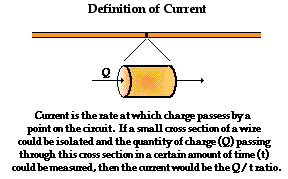Electric Current
Electric current is the rate of charge flow(of electrons from negaticely charged end to a positively charged end), measured in Coulombs/second which is named Amperes.
Conventional current and electric flow

An electron flow is the movement of electrons towards the positively charged end.
While,
Conventional current flow is the assumption of scientists that an electric current consisted of positive charges flowing from a positively charged end to a negatively charged end.

(Imaginary positive particles moving in the direction of the conventional current).
How is electric current measured?
Since electric current involves moving electric charges, it can be measured by determining the amount of electric charge that passes through a conductor.
Current is the rate at which charge flows past a point on a circuit. As depicted in the diagram below, the current in a circuit can be determined if the quantity of charge Q passing through a cross section of a wire in a time t can be measured. The current is simply the ratio of the quantity of charge and time.

Current is a rate quantity.

Note that the equation above uses the symbol I to represent the quantity current.
The S.I. unit for current is the ampere. Ampere is often shortened to Amp and is abbreviated by the unit symbol A. A current of 1 ampere means that there is 1 coulomb of charge passing through a cross section of a wire every 1 second.
1 ampere = 1 coulomb / 1 second

Electric current is measured using an ammeter.
The ammeter must be connected in series in an electric circuit.
The ammeter must be connected in series in an electric circuit.
Electric Circuit symbols

A basic closed electrical circuit is made of four basic parts.
1. Electrical Energy Source : The energy source that drives the electric charge round the circuit
2. Electrical conductors or wires : Conductors are used to connect the components together.
3. Electrical load : This enables moving charges to do a useful job. Examples include this computer or even an electric bulb
4. Electrical switch : This enables the users to open and close the circuit.
An open circuit occurs when there is a break in the circuit to stop the current from
flowing.
Electromotive force
In an electric circuit, electromotive force is the work done by a source in driving a unit charge round a complete circuit.
It is more commonly referred to by the initials EMF. EMF is another term for electrical potential, or the difference in charge across a battery or voltage source.
In symbols:
1. Electrical Energy Source : The energy source that drives the electric charge round the circuit
2. Electrical conductors or wires : Conductors are used to connect the components together.
3. Electrical load : This enables moving charges to do a useful job. Examples include this computer or even an electric bulb
4. Electrical switch : This enables the users to open and close the circuit.
An open circuit occurs when there is a break in the circuit to stop the current from
flowing.
Electromotive force
In an electric circuit, electromotive force is the work done by a source in driving a unit charge round a complete circuit.
It is more commonly referred to by the initials EMF. EMF is another term for electrical potential, or the difference in charge across a battery or voltage source.
In symbols:
ε = W/Q
where ,
ε - e.m.f. of the power supply,
W - Amount of electrical energy converted from non-electrical forms (work done)
Q - Amount of Charge
The S.I. unit of e.m.f. is joules per coulomb ( J/C) or Volt (V)
ε - e.m.f. of the power supply,
W - Amount of electrical energy converted from non-electrical forms (work done)
Q - Amount of Charge
The S.I. unit of e.m.f. is joules per coulomb ( J/C) or Volt (V)
How do we measure e.m.f.?
To measure e.m.f, we use a volmeter connected in parellel to the circuit.
What is potential difference?
The potential difference (p.d.) between two points in an electric circuit is defined as the amount of electrical energy converted to other forms of energy when one coulomb of positive charge passes between the two points.
In Symbols:
V = W/Q
where,
V is the potential difference,
W is the electrical energy converted to other forms,
Q is the amount of Charge
The SI unit for the potential difference is the same as that for e.m.f., Volt(V).
No comments:
Post a Comment